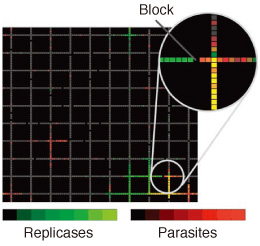Research Abstract
氷はRNA複製の原始細胞的な媒体である
初期地球の気温条件で広くみられる単純な媒質である氷の物理化学的性質が、膜をもつ原始細胞の出現に先立ってこの転換を仲介した可能性を示す。
Ice as a protocellular medium for RNA replication
2010年9月21日 Nature Communications 1 : 76 doi: 10.1038/ncomms1076

生命の起源における重大な変化は、自己複製可能な情報保持ポリマーの出現と、それを原始細胞構造内で小区画内に隔離したことであった。我々は、初期地球の 気温条件で広くみられる単純な媒質である氷の物理化学的性質が、膜をもつ原始細胞の出現に先立ってこの転換を仲介した可能性を示す。氷は、RNAポリメ ラーゼであるリボザイムの働きを促進するばかりでなく、リボザイムを加水分解から守って、例外的に長い複製産物の合成を可能にする。氷はまた、生物出現以 前にはあり得ないと考えられる基質濃度に依存するRNA複製が起こるのを助け、一方で、共晶相の複雑な微細構造中で細胞のような区画化を引き起こす。共晶 氷相は以前に、ヌクレオチド前駆体のde novo合成を促進し、また活性化したヌクレオチドを濃縮してランダムRNAオリゴマーとするこ とが明らかにされている。我々の結果は、こうした反応を起こりやすくする環境として、氷がより広い役割をもち、生物出現以前に起こった合成のすべての段階 を促進してRNA自己複製の出現と細胞出現以前のダーウィン的進化を促進したことを裏付けている。
- MRC分子生物学研究所(英)
A crucial transition in the origin of life was the emergence of an informational polymer capable of self-replication and its compartmentalization within protocellular structures. We show that the physicochemical properties of ice, a simple medium widespread on a temperate early Earth, could have mediated this transition prior to the advent of membraneous protocells. Ice not only promotes the activity of an RNA polymerase ribozyme but also protects it from hydrolytic degradation, enabling the synthesis of exceptionally long replication products. Ice furthermore relieves the dependence of RNA replication on prebiotically implausible substrate concentrations, while providing quasicellular compartmentalization within the intricate microstructure of the eutectic phase. Eutectic ice phases had previously been shown to promote the de novo synthesis of nucleotide precursors, as well as the condensation of activated nucleotides into random RNA oligomers. Our results support a wider role for ice as a predisposed environment, promoting all the steps from prebiotic synthesis to the emergence of RNA self-replication and precellular Darwinian evolution.

